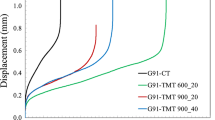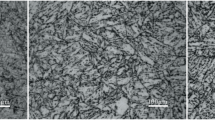Abstract
This paper describes a study carried out at room temperature on an Fe-21 pct Cr-11 pct Ni heat resisting alloy under tensile and fatigue deformation. Specific microstructures were developed by heat treating the as-received alloy at different temperatures and times. The surface condition of all specimens displayed surface grain boundary oxidation to a maximum depth of 0.16 mm. In addition, the microstructure of specimens in one batch (B) contained intergranular chromium carbides. The major conclusions drawn from this study are that different microstructures respond differently to monotonie and cyclic modes of deformation. In particular, the embrittling effect of intergranular chromium carbides observed during the monotonie mode of deformation was different from that found when deformation was cyclic. During cyclic deformation these chromium carbides assisted in reducing the damaging effects of the surface grain boundary oxidation. Also during cyclic deformation, the overall fatigue life was found to depend on the mode of both fatigue crack initiation and Stage I crack growth. Fatigue life was reduced when crack initiation and Stage I crack growth were intergranular while it was enhanced when crack initiation occurred at slip bands and subsequent Stage I crack growth was transgranular. It was observed that surface grain boundary oxidation is a most deleterious micro-structural feature especially under fatigue loading but, if this feature is unavoidable then the presence of intergranular chromium carbides is considered to be highly beneficial in increasing the overall fatigue resistance of the material.
Similar content being viewed by others
References
J.C. Grosskreutz:Metall. Trans., 1972, vol. 3, pp. 1255–62.
Y. Nakada and B. Chalmers:J. Appl. Phys., 1962, vol. 33, pp. 3307–08.
S. Kitajama, H. Tanaka, and H. Kaieda:Trans. JIM, 1968, vol. 10, pp. 12–16.
I. R. Kramer:Metall. Trans., 1974, vol. 5, pp. 1735–42.
C. Calabrese and C. Laird:Metall. Trans., 1974, vol. 5, pp. 1785–93.
H.F. Merrick:Metall. Trans., 1974, vol. 5, pp. 891–97.
D. Fournier and A. Pineau:Metall. Trans. A, 1977, vol. 8A, pp. 1095–1105.
E. O. Hall:Proc. Phys. Soc. (London), 1951, vol. 64, section B, pp. 747–53.
N.J. Petch:J. Iron Steel Inst., 1953, vol. 174, pp. 25–28.
R.W. Armstrong, I. Codd, R. M. Douthwaite, and N.J. Petch:Phil. Mag., 1962, vol. 7, pp. 45–58.
A. P. L. Turner:Metall. Trans. A, 1979, vol. 10A, pp. 225–34.
O. Helgeland:J. Inst. Metals, 1965, vol. 93, pp. 570–75.
W. N. Roberts:Phil. Mag., 1969, vol. 20, pp. 675–86.
Author information
Authors and Affiliations
Additional information
Formerly a Postgraduate Student, School of Materials Science and Engineering, University of New South Wales, Kensington, New South Wales 2033.
Rights and permissions
About this article
Cite this article
Khan, M.Z.S., Thompson, K.R.L. The effect of microstructure on the mode of monotonie fracture, fatigue crack initiation, and stage i crack growth in an Fe-21 Pct Cr-11 Pct Ni heat resisting steel. Metall Trans A 18, 1951–1960 (1987). https://doi.org/10.1007/BF02647025
Received:
Issue Date:
DOI: https://doi.org/10.1007/BF02647025




